Exploring Educational Theories and Practical Classroom Applications
VerifiedAdded on 2022/11/17
|6
|1429
|155
Essay
AI Summary
This essay delves into various educational theories and their practical applications. It begins by exploring the behaviorist view, discussing its principles and providing an example of its use by a teacher. The essay then transitions to social cognitive and constructive learning theories, highlighting the contributions of theorists like Piaget and Vygotsky, and illustrating their classroom applications. Furthermore, the paper addresses the importance of motivation and engagement in learning, offering examples of how teachers can apply these principles. The Premack Principle is also discussed, providing real-world examples of its use in educational settings. The essay concludes by emphasizing the importance of understanding both environmental and internal factors that affect a student's growth and development, as well as the significance of these theories in promoting literacy and efficiency in the learning process. The paper uses references from various sources to support its arguments.
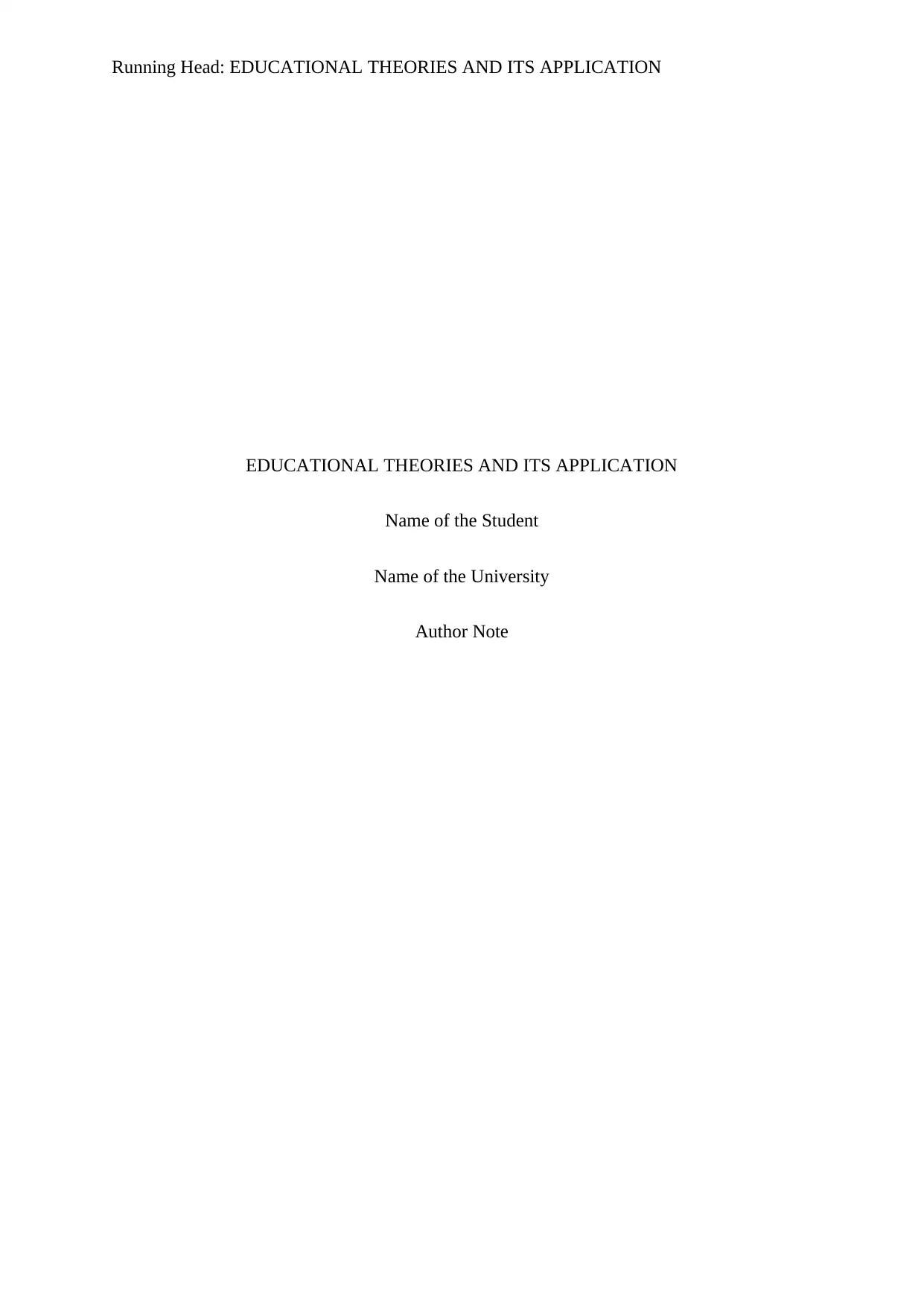
Running Head: EDUCATIONAL THEORIES AND ITS APPLICATION
EDUCATIONAL THEORIES AND ITS APPLICATION
Name of the Student
Name of the University
Author Note
EDUCATIONAL THEORIES AND ITS APPLICATION
Name of the Student
Name of the University
Author Note
Paraphrase This Document
Need a fresh take? Get an instant paraphrase of this document with our AI Paraphraser
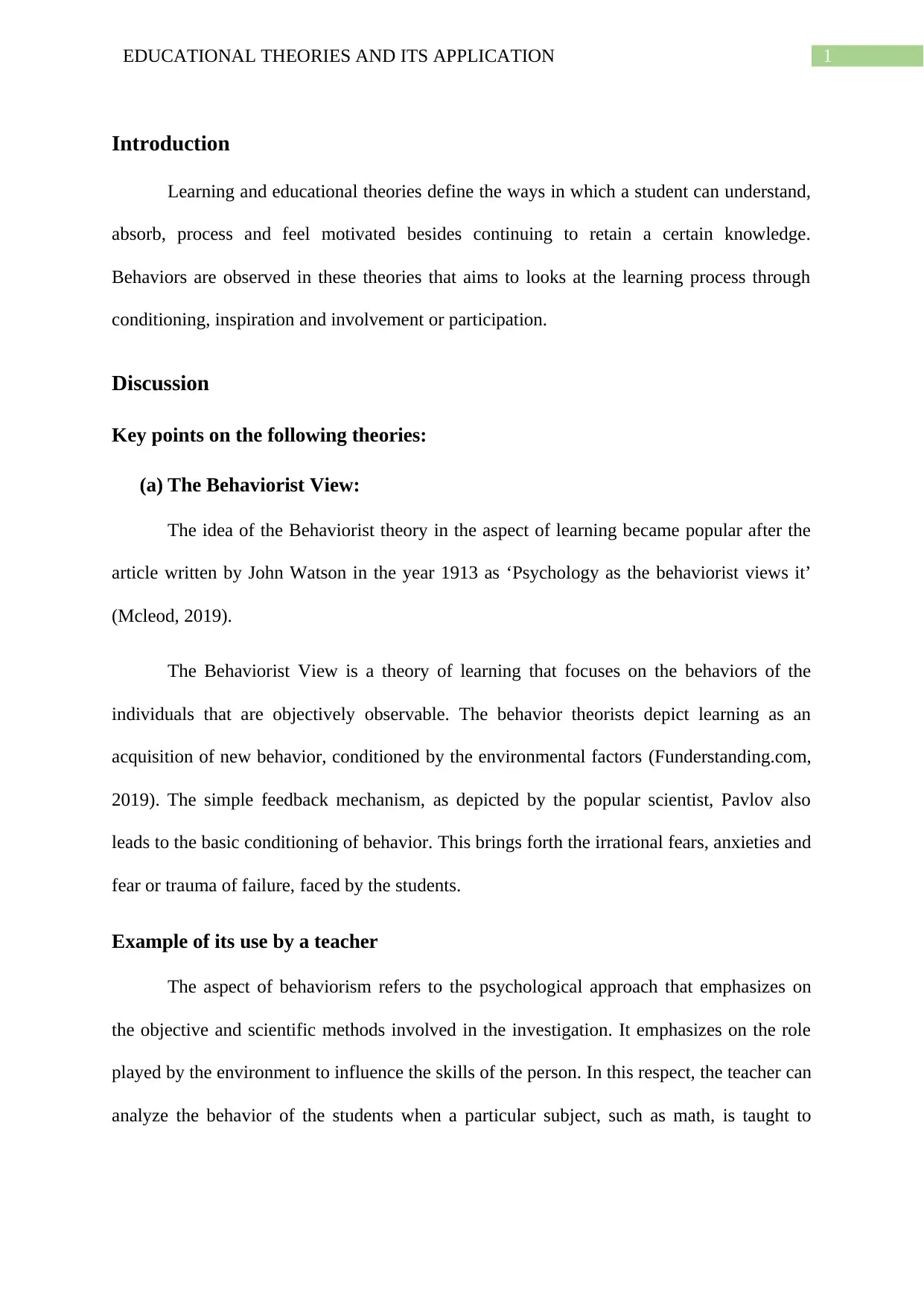
1EDUCATIONAL THEORIES AND ITS APPLICATION
Introduction
Learning and educational theories define the ways in which a student can understand,
absorb, process and feel motivated besides continuing to retain a certain knowledge.
Behaviors are observed in these theories that aims to looks at the learning process through
conditioning, inspiration and involvement or participation.
Discussion
Key points on the following theories:
(a) The Behaviorist View:
The idea of the Behaviorist theory in the aspect of learning became popular after the
article written by John Watson in the year 1913 as ‘Psychology as the behaviorist views it’
(Mcleod, 2019).
The Behaviorist View is a theory of learning that focuses on the behaviors of the
individuals that are objectively observable. The behavior theorists depict learning as an
acquisition of new behavior, conditioned by the environmental factors (Funderstanding.com,
2019). The simple feedback mechanism, as depicted by the popular scientist, Pavlov also
leads to the basic conditioning of behavior. This brings forth the irrational fears, anxieties and
fear or trauma of failure, faced by the students.
Example of its use by a teacher
The aspect of behaviorism refers to the psychological approach that emphasizes on
the objective and scientific methods involved in the investigation. It emphasizes on the role
played by the environment to influence the skills of the person. In this respect, the teacher can
analyze the behavior of the students when a particular subject, such as math, is taught to
Introduction
Learning and educational theories define the ways in which a student can understand,
absorb, process and feel motivated besides continuing to retain a certain knowledge.
Behaviors are observed in these theories that aims to looks at the learning process through
conditioning, inspiration and involvement or participation.
Discussion
Key points on the following theories:
(a) The Behaviorist View:
The idea of the Behaviorist theory in the aspect of learning became popular after the
article written by John Watson in the year 1913 as ‘Psychology as the behaviorist views it’
(Mcleod, 2019).
The Behaviorist View is a theory of learning that focuses on the behaviors of the
individuals that are objectively observable. The behavior theorists depict learning as an
acquisition of new behavior, conditioned by the environmental factors (Funderstanding.com,
2019). The simple feedback mechanism, as depicted by the popular scientist, Pavlov also
leads to the basic conditioning of behavior. This brings forth the irrational fears, anxieties and
fear or trauma of failure, faced by the students.
Example of its use by a teacher
The aspect of behaviorism refers to the psychological approach that emphasizes on
the objective and scientific methods involved in the investigation. It emphasizes on the role
played by the environment to influence the skills of the person. In this respect, the teacher can
analyze the behavior of the students when a particular subject, such as math, is taught to
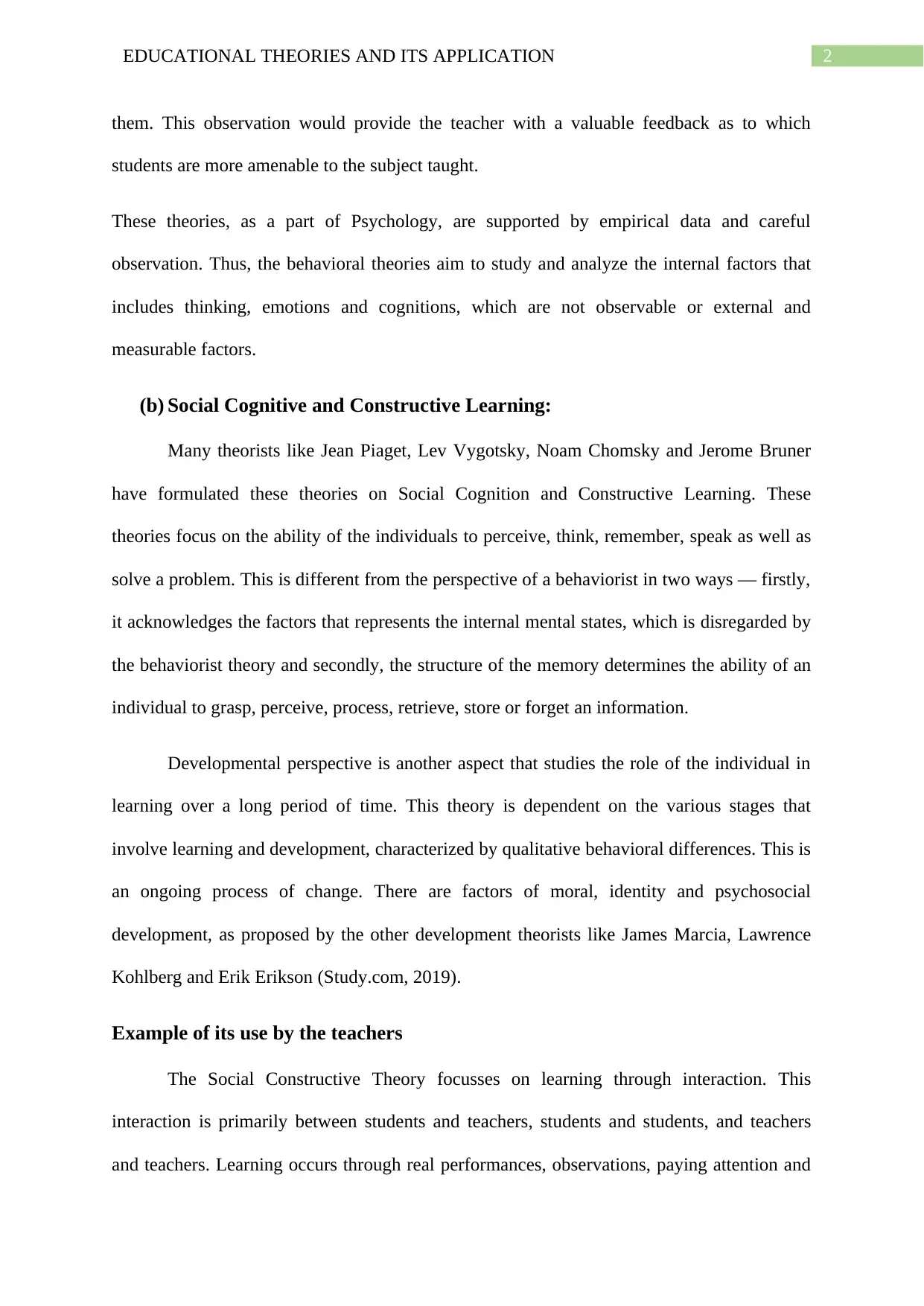
2EDUCATIONAL THEORIES AND ITS APPLICATION
them. This observation would provide the teacher with a valuable feedback as to which
students are more amenable to the subject taught.
These theories, as a part of Psychology, are supported by empirical data and careful
observation. Thus, the behavioral theories aim to study and analyze the internal factors that
includes thinking, emotions and cognitions, which are not observable or external and
measurable factors.
(b) Social Cognitive and Constructive Learning:
Many theorists like Jean Piaget, Lev Vygotsky, Noam Chomsky and Jerome Bruner
have formulated these theories on Social Cognition and Constructive Learning. These
theories focus on the ability of the individuals to perceive, think, remember, speak as well as
solve a problem. This is different from the perspective of a behaviorist in two ways — firstly,
it acknowledges the factors that represents the internal mental states, which is disregarded by
the behaviorist theory and secondly, the structure of the memory determines the ability of an
individual to grasp, perceive, process, retrieve, store or forget an information.
Developmental perspective is another aspect that studies the role of the individual in
learning over a long period of time. This theory is dependent on the various stages that
involve learning and development, characterized by qualitative behavioral differences. This is
an ongoing process of change. There are factors of moral, identity and psychosocial
development, as proposed by the other development theorists like James Marcia, Lawrence
Kohlberg and Erik Erikson (Study.com, 2019).
Example of its use by the teachers
The Social Constructive Theory focusses on learning through interaction. This
interaction is primarily between students and teachers, students and students, and teachers
and teachers. Learning occurs through real performances, observations, paying attention and
them. This observation would provide the teacher with a valuable feedback as to which
students are more amenable to the subject taught.
These theories, as a part of Psychology, are supported by empirical data and careful
observation. Thus, the behavioral theories aim to study and analyze the internal factors that
includes thinking, emotions and cognitions, which are not observable or external and
measurable factors.
(b) Social Cognitive and Constructive Learning:
Many theorists like Jean Piaget, Lev Vygotsky, Noam Chomsky and Jerome Bruner
have formulated these theories on Social Cognition and Constructive Learning. These
theories focus on the ability of the individuals to perceive, think, remember, speak as well as
solve a problem. This is different from the perspective of a behaviorist in two ways — firstly,
it acknowledges the factors that represents the internal mental states, which is disregarded by
the behaviorist theory and secondly, the structure of the memory determines the ability of an
individual to grasp, perceive, process, retrieve, store or forget an information.
Developmental perspective is another aspect that studies the role of the individual in
learning over a long period of time. This theory is dependent on the various stages that
involve learning and development, characterized by qualitative behavioral differences. This is
an ongoing process of change. There are factors of moral, identity and psychosocial
development, as proposed by the other development theorists like James Marcia, Lawrence
Kohlberg and Erik Erikson (Study.com, 2019).
Example of its use by the teachers
The Social Constructive Theory focusses on learning through interaction. This
interaction is primarily between students and teachers, students and students, and teachers
and teachers. Learning occurs through real performances, observations, paying attention and
⊘ This is a preview!⊘
Do you want full access?
Subscribe today to unlock all pages.

Trusted by 1+ million students worldwide
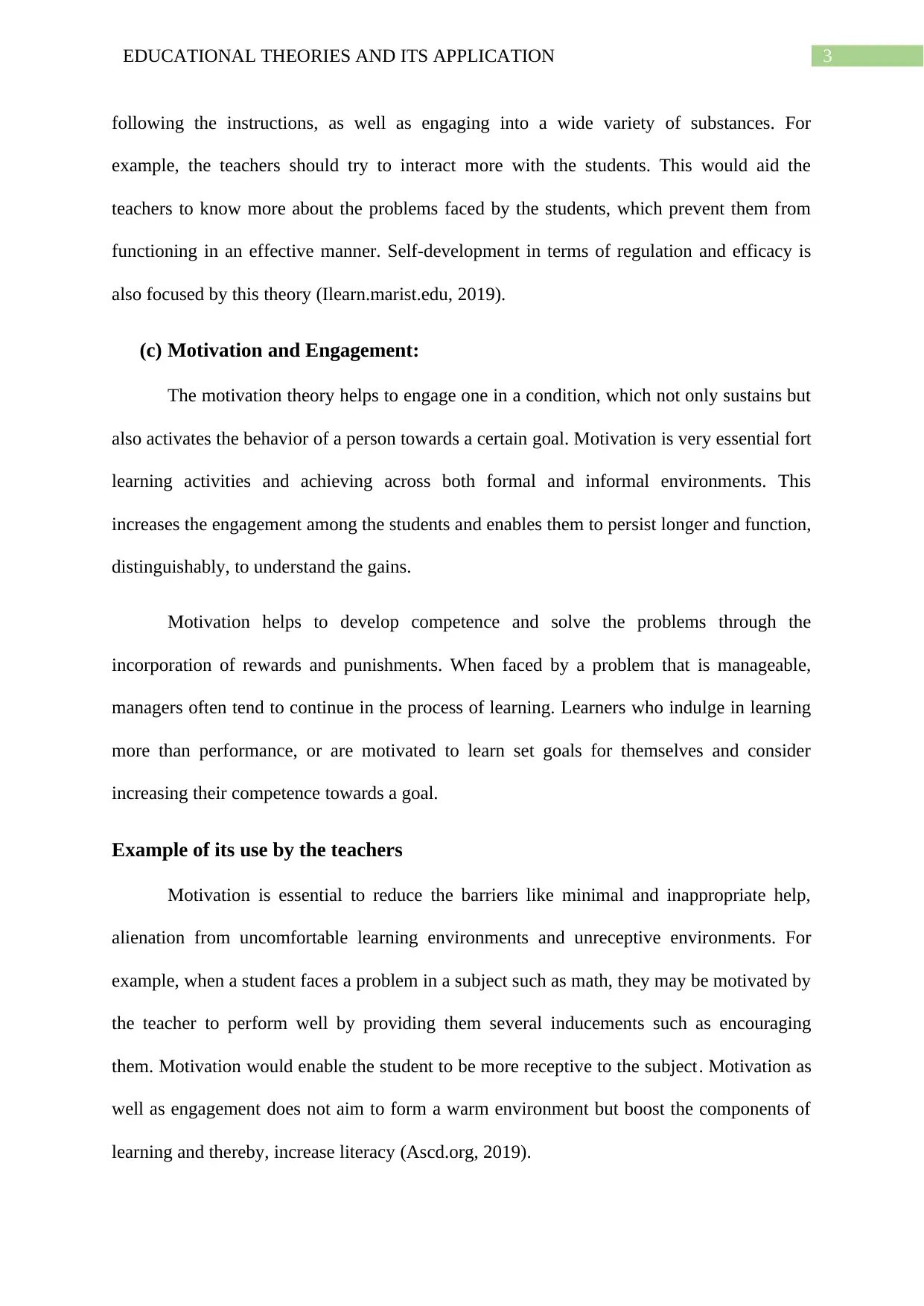
3EDUCATIONAL THEORIES AND ITS APPLICATION
following the instructions, as well as engaging into a wide variety of substances. For
example, the teachers should try to interact more with the students. This would aid the
teachers to know more about the problems faced by the students, which prevent them from
functioning in an effective manner. Self-development in terms of regulation and efficacy is
also focused by this theory (Ilearn.marist.edu, 2019).
(c) Motivation and Engagement:
The motivation theory helps to engage one in a condition, which not only sustains but
also activates the behavior of a person towards a certain goal. Motivation is very essential fort
learning activities and achieving across both formal and informal environments. This
increases the engagement among the students and enables them to persist longer and function,
distinguishably, to understand the gains.
Motivation helps to develop competence and solve the problems through the
incorporation of rewards and punishments. When faced by a problem that is manageable,
managers often tend to continue in the process of learning. Learners who indulge in learning
more than performance, or are motivated to learn set goals for themselves and consider
increasing their competence towards a goal.
Example of its use by the teachers
Motivation is essential to reduce the barriers like minimal and inappropriate help,
alienation from uncomfortable learning environments and unreceptive environments. For
example, when a student faces a problem in a subject such as math, they may be motivated by
the teacher to perform well by providing them several inducements such as encouraging
them. Motivation would enable the student to be more receptive to the subject. Motivation as
well as engagement does not aim to form a warm environment but boost the components of
learning and thereby, increase literacy (Ascd.org, 2019).
following the instructions, as well as engaging into a wide variety of substances. For
example, the teachers should try to interact more with the students. This would aid the
teachers to know more about the problems faced by the students, which prevent them from
functioning in an effective manner. Self-development in terms of regulation and efficacy is
also focused by this theory (Ilearn.marist.edu, 2019).
(c) Motivation and Engagement:
The motivation theory helps to engage one in a condition, which not only sustains but
also activates the behavior of a person towards a certain goal. Motivation is very essential fort
learning activities and achieving across both formal and informal environments. This
increases the engagement among the students and enables them to persist longer and function,
distinguishably, to understand the gains.
Motivation helps to develop competence and solve the problems through the
incorporation of rewards and punishments. When faced by a problem that is manageable,
managers often tend to continue in the process of learning. Learners who indulge in learning
more than performance, or are motivated to learn set goals for themselves and consider
increasing their competence towards a goal.
Example of its use by the teachers
Motivation is essential to reduce the barriers like minimal and inappropriate help,
alienation from uncomfortable learning environments and unreceptive environments. For
example, when a student faces a problem in a subject such as math, they may be motivated by
the teacher to perform well by providing them several inducements such as encouraging
them. Motivation would enable the student to be more receptive to the subject. Motivation as
well as engagement does not aim to form a warm environment but boost the components of
learning and thereby, increase literacy (Ascd.org, 2019).
Paraphrase This Document
Need a fresh take? Get an instant paraphrase of this document with our AI Paraphraser
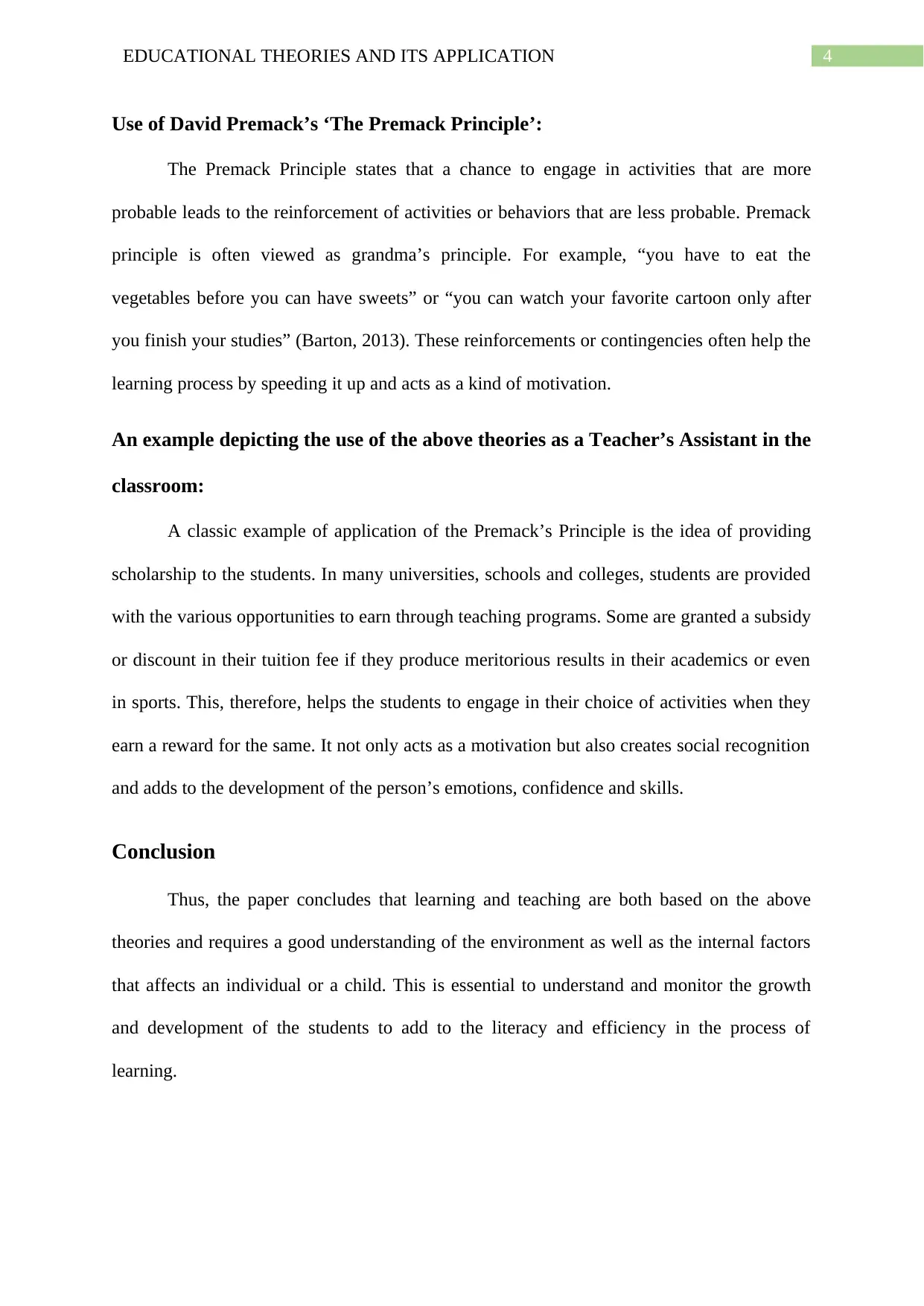
4EDUCATIONAL THEORIES AND ITS APPLICATION
Use of David Premack’s ‘The Premack Principle’:
The Premack Principle states that a chance to engage in activities that are more
probable leads to the reinforcement of activities or behaviors that are less probable. Premack
principle is often viewed as grandma’s principle. For example, “you have to eat the
vegetables before you can have sweets” or “you can watch your favorite cartoon only after
you finish your studies” (Barton, 2013). These reinforcements or contingencies often help the
learning process by speeding it up and acts as a kind of motivation.
An example depicting the use of the above theories as a Teacher’s Assistant in the
classroom:
A classic example of application of the Premack’s Principle is the idea of providing
scholarship to the students. In many universities, schools and colleges, students are provided
with the various opportunities to earn through teaching programs. Some are granted a subsidy
or discount in their tuition fee if they produce meritorious results in their academics or even
in sports. This, therefore, helps the students to engage in their choice of activities when they
earn a reward for the same. It not only acts as a motivation but also creates social recognition
and adds to the development of the person’s emotions, confidence and skills.
Conclusion
Thus, the paper concludes that learning and teaching are both based on the above
theories and requires a good understanding of the environment as well as the internal factors
that affects an individual or a child. This is essential to understand and monitor the growth
and development of the students to add to the literacy and efficiency in the process of
learning.
Use of David Premack’s ‘The Premack Principle’:
The Premack Principle states that a chance to engage in activities that are more
probable leads to the reinforcement of activities or behaviors that are less probable. Premack
principle is often viewed as grandma’s principle. For example, “you have to eat the
vegetables before you can have sweets” or “you can watch your favorite cartoon only after
you finish your studies” (Barton, 2013). These reinforcements or contingencies often help the
learning process by speeding it up and acts as a kind of motivation.
An example depicting the use of the above theories as a Teacher’s Assistant in the
classroom:
A classic example of application of the Premack’s Principle is the idea of providing
scholarship to the students. In many universities, schools and colleges, students are provided
with the various opportunities to earn through teaching programs. Some are granted a subsidy
or discount in their tuition fee if they produce meritorious results in their academics or even
in sports. This, therefore, helps the students to engage in their choice of activities when they
earn a reward for the same. It not only acts as a motivation but also creates social recognition
and adds to the development of the person’s emotions, confidence and skills.
Conclusion
Thus, the paper concludes that learning and teaching are both based on the above
theories and requires a good understanding of the environment as well as the internal factors
that affects an individual or a child. This is essential to understand and monitor the growth
and development of the students to add to the literacy and efficiency in the process of
learning.
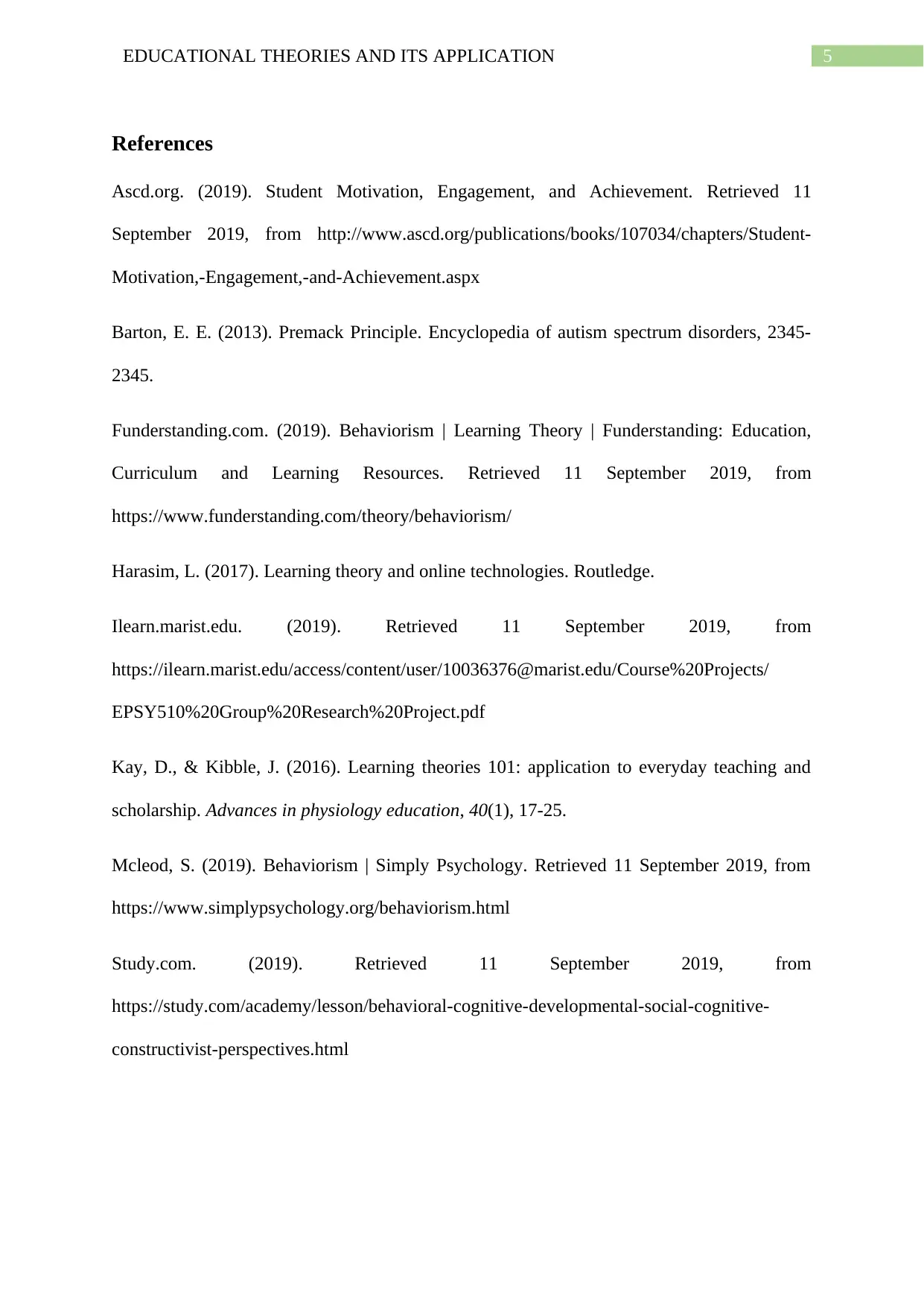
5EDUCATIONAL THEORIES AND ITS APPLICATION
References
Ascd.org. (2019). Student Motivation, Engagement, and Achievement. Retrieved 11
September 2019, from http://www.ascd.org/publications/books/107034/chapters/Student-
Motivation,-Engagement,-and-Achievement.aspx
Barton, E. E. (2013). Premack Principle. Encyclopedia of autism spectrum disorders, 2345-
2345.
Funderstanding.com. (2019). Behaviorism | Learning Theory | Funderstanding: Education,
Curriculum and Learning Resources. Retrieved 11 September 2019, from
https://www.funderstanding.com/theory/behaviorism/
Harasim, L. (2017). Learning theory and online technologies. Routledge.
Ilearn.marist.edu. (2019). Retrieved 11 September 2019, from
https://ilearn.marist.edu/access/content/user/10036376@marist.edu/Course%20Projects/
EPSY510%20Group%20Research%20Project.pdf
Kay, D., & Kibble, J. (2016). Learning theories 101: application to everyday teaching and
scholarship. Advances in physiology education, 40(1), 17-25.
Mcleod, S. (2019). Behaviorism | Simply Psychology. Retrieved 11 September 2019, from
https://www.simplypsychology.org/behaviorism.html
Study.com. (2019). Retrieved 11 September 2019, from
https://study.com/academy/lesson/behavioral-cognitive-developmental-social-cognitive-
constructivist-perspectives.html
References
Ascd.org. (2019). Student Motivation, Engagement, and Achievement. Retrieved 11
September 2019, from http://www.ascd.org/publications/books/107034/chapters/Student-
Motivation,-Engagement,-and-Achievement.aspx
Barton, E. E. (2013). Premack Principle. Encyclopedia of autism spectrum disorders, 2345-
2345.
Funderstanding.com. (2019). Behaviorism | Learning Theory | Funderstanding: Education,
Curriculum and Learning Resources. Retrieved 11 September 2019, from
https://www.funderstanding.com/theory/behaviorism/
Harasim, L. (2017). Learning theory and online technologies. Routledge.
Ilearn.marist.edu. (2019). Retrieved 11 September 2019, from
https://ilearn.marist.edu/access/content/user/10036376@marist.edu/Course%20Projects/
EPSY510%20Group%20Research%20Project.pdf
Kay, D., & Kibble, J. (2016). Learning theories 101: application to everyday teaching and
scholarship. Advances in physiology education, 40(1), 17-25.
Mcleod, S. (2019). Behaviorism | Simply Psychology. Retrieved 11 September 2019, from
https://www.simplypsychology.org/behaviorism.html
Study.com. (2019). Retrieved 11 September 2019, from
https://study.com/academy/lesson/behavioral-cognitive-developmental-social-cognitive-
constructivist-perspectives.html
⊘ This is a preview!⊘
Do you want full access?
Subscribe today to unlock all pages.

Trusted by 1+ million students worldwide
1 out of 6
Related Documents
Your All-in-One AI-Powered Toolkit for Academic Success.
+13062052269
info@desklib.com
Available 24*7 on WhatsApp / Email
![[object Object]](/_next/static/media/star-bottom.7253800d.svg)
Unlock your academic potential
Copyright © 2020–2025 A2Z Services. All Rights Reserved. Developed and managed by ZUCOL.





